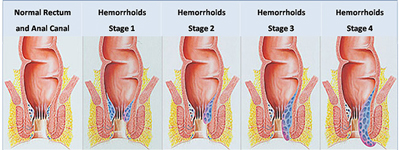
Piles are very common but not something you'll want to talk to your friends about. We don't know precisely how common piles are because many piles are small and not seen by a doctor. Piles often don't cause any problems but can cause bleeding and sometimes pain. If they do cause any bleeding or pain then you should contact a doctor.
The lining of the back passage (anal canal) contains many blood vessels (veins). There seem to be certain changes in the veins within the lining of the back passage that cause the pile(s) to develop. The lining of the back passage and the veins become much larger and this can then cause a swelling and develop into a pile.
However, we don't know exactly what causes a pile. Some piles seem to develop for no apparent reason. It is thought that there is an increased pressure in and around the opening of the back passage (anus). This is probably a major factor in causing haemorrhoids in many cases. If you delay going to the toilet and need to strain when on the toilet then this can increase the pressure and so makes it more likely that a pile will develop.
The symptoms of piles depends upon where it has occured. If the internal veins are effected, then the person doesn't feel much uncomfort. If the external veins are effected, then the person experience more feel. Tne lmps can be feel of the anal opening. Itching and irritation around the anus and passage of blood in stool are common symptoms of piles.
Chronic Constipation an Diahhrea cause severe pressure on veins arround the rings. This can lead to piles. Sometimes pregnant women develop this condition due to the weight of the feets and increase in the blood flow. Heavy weight lifting jobs and consumption of too many spices and condomens also causes this condition.
There are certain situations that increase the chance of piles developing:
• Constipation, passing large stools (faeces), and straining at the toilet. These increase the pressure in and around the veins in the anus and seem to be a common reason for piles to develop.
• Being overweight. This increases your risk of developing piles.
• Pregnancy. Piles are common during pregnancy. This is probably due to pressure effects of the baby lying above the rectum and anus, and also the affect that the change in hormones during pregnancy can have on the veins. Piles occurring during pregnancy often go away after the birth of the child.
• Ageing. The tissues in the lining of the anus may become less supportive as we become older.
• Hereditary factors. Some people may inherit a weakness of the wall of the veins in the anal region.
• Other possible causes of piles include heavy lifting or a persistent (chronic) cough.


Piles can be divided into either internal or external piles. Some people develop internal and external piles at the same time.
• Internal piles are deeper and initially form above a point 2-3 cm inside the back passage (anal canal) in the upper part of the anal canal.
• External piles start off nearer the surface, below a point 2-3 cm inside the back passage.
Despite the name, external piles aren't always seen outside of the opening of the back passage (anus). Equally confusing, internal piles can enlarge and drop down (prolapse), so that they hang outside of the anus.
Inflammation of veins in and arround the rectum leads to piles or hemeroids. The symptoms of piles
In Ayurveda, we can cure piles in many ways. There are some procedures for the treatment of Piles. Such as:
Banding Treatment
This procedure is usually done by a surgeon in an outpatient clinic. A haemorrhoid is grasped by the surgeon with forceps or a suction device. A rubber band is then placed at the base of the haemorrhoid. This cuts off the blood supply to the haemorrhoid which then dies and drops off after a few days. The tissue at the base of the haemorrhoid heals with some scar tissue.
Banding of internal piles is usually painless, as the base of the haemorrhoid originates above the anal opening in the very last part of the gut where the gut lining is not sensitive to pain.
A small number of people have complications following banding, such as bleeding, infection or ulcers forming at the site of a treated haemorrhoid, or urinary problems.
Infrared coagulation/photocoagulation
This method uses infrared energy to burn and cut off the circulation to the haemorrhoid, which causes it to shrink in size. It seems to be as effective as banding treatment and injection sclerotherapy for first- and second-degree piles.
Other Remedies
Take one zeera powder. Add little water it. Mix it thoroughly. Apply this paste in affected area. Leave it for 15 to 20 minutes. Then wash it with normal water. Do this for twice a day.
Take one crushed radish. Add little milk to it. Mix it well to make this as a thick paste. Appply this paste on the piles near the anal opening. Leave it for 15 to 20 minutes and do it twice daily